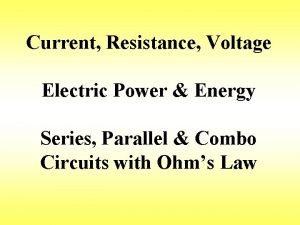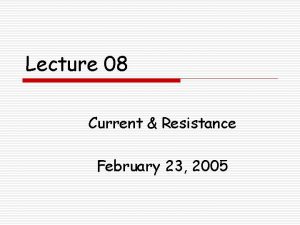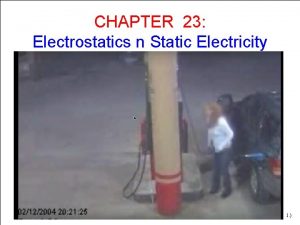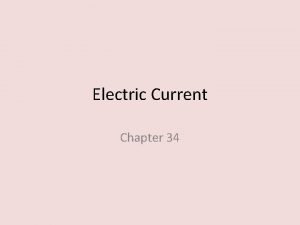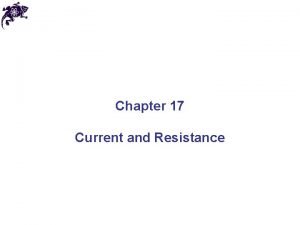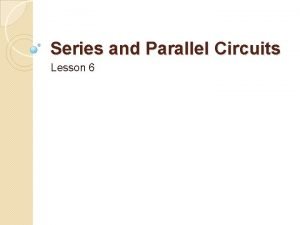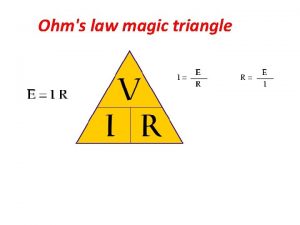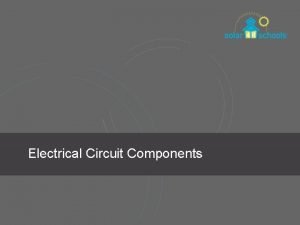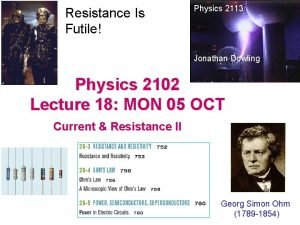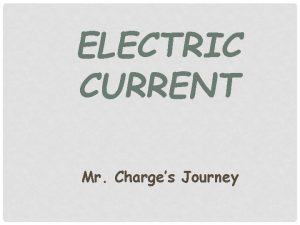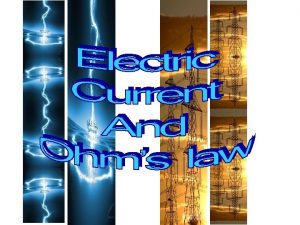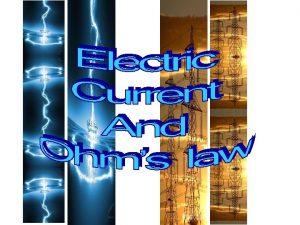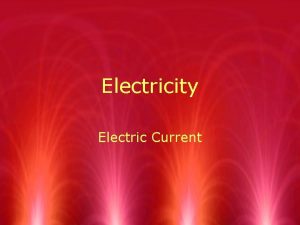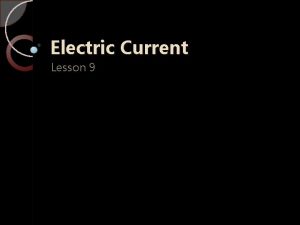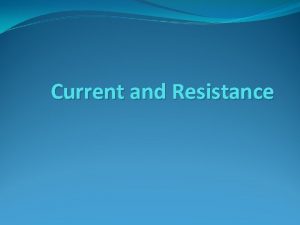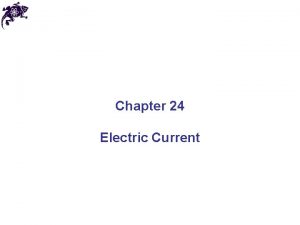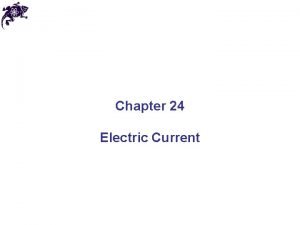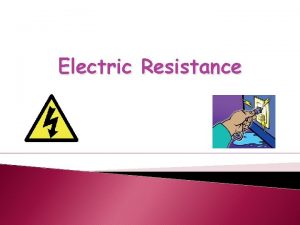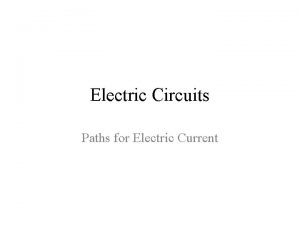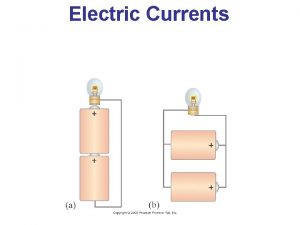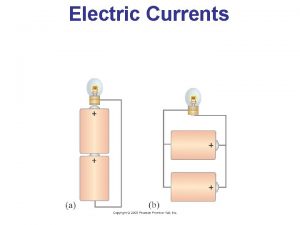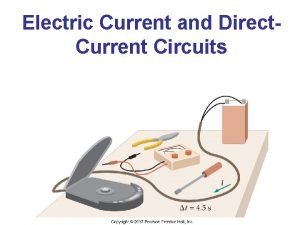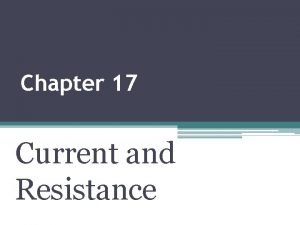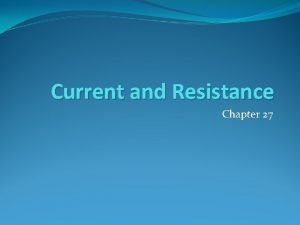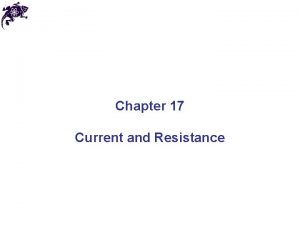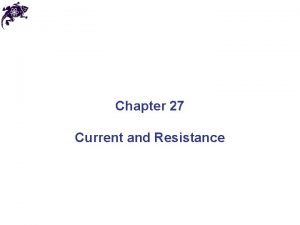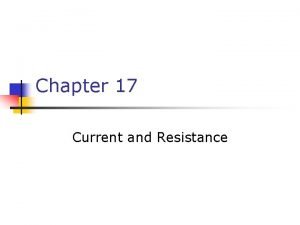Chapter 27 Current and Resistance 27 1 Electric


































- Slides: 34

Chapter 27: Current and Resistance 27. 1 Electric Current 27. 2 Resistance and Ohm’s Law 27. 3 Resistance and Temperature 27. 6 Electrical Energy and Power Slide 1 Fig 27 -CO, p. 831

27 -1 Electric Current # Now consider a system of electric charges in motion. Whenever there is a net flow of charge through some region, a current is said to exist. …. the charges are moving perpendicular to a surface of area A, The current is the rate at which charge flows through this surface. average current Slide 2 instantaneous current

The SI unit of current is the ampere (A): That is, 1 A of current is equivalent to 1 C of charge passing through the surface area in 1 s. #. . It is conventional to assign to the current the same direction as the flow of positive charge #. . the direction of the current is opposite the direction of flow of electrons. # It is common to refer to a moving charge (positive or negative) as a mobile charge carrier. For example, the mobile charge carriers in a metal are electrons.

Microscopic Model of Current ΔQ = number of carriers in section x charge per carrier = (n A Δ x)q ΔQ = (n. A vd Δ t) q The speed of the charge carriers vd is an average speed called the drift speed. Fig 27 -2, p. 833

consider a conductor in which the charge carriers are free electrons. If the conductor is isolated—that is, the potential difference across it is zero—then these electrons undergo random motion that is analogous to the motion of gas molecules. when a potential difference is applied across the conductor (for example, by means of a battery), an electric field is set up in the conductor; this field exerts an electric force on the electrons, producing a current. However, the electrons do not move in straight lines along the conductor. Instead, they collide repeatedly with the metal atoms, and their resultant motion is complicated and zigzag (Fig. 27. 3). Despite the collisions, the electrons move slowly along the conductor (in a direction opposite that of E) at the drift velocity v d.

Fig 27 -3, p. 834

A copper wire in a typical residential building has a cross-sectional area of 3. 31 x 106 m 2. If it carries a current of 10. 0 A, what is the drift speed of the electrons? Assume that each copper atom contributes one free electron to the current. The density of copper is 8. 95 g/cm 3. (Atomic mass of cupper is 63. 5 g/mol. # Recall that 1 mol of any substance contains Avogadro’s number of atoms (6. 02 x 1023). Knowing the density of copper, we can calculate the volume occupied by 63. 5 g (≡ 1 mol) of copper:

Consider a conductor of cross-sectional area A carrying a current I. The current density J in the conductor is defined as the current per unit area. Because the current = n. Aqvd. A the current density is A current density J and an electric field E are established in a conductor whenever a potential difference is maintained across the conductor. If the potential difference is constant, then the current also is constant. In some materials, the current density is proportional to the electric field:

where the constant of proportionalityσ is called the conductivity of the conductor. Materials that obey Equation # are said to follow Ohm’s law More specifically, Ohm’s law states that ; for many materials (including most metals), the ratio of the current density to the electric field is a constant σ that is independent of the electric field producing the current. Materials that obey Ohm’s law and hence demonstrate this simple relationship between E and J are said to be ohmic, Materials that do not obey Ohm’s law are said to be non-ohmic Fig 27 -5, p. 836

We can obtain a form of Ohm’s law useful in practical applications by considering a segment of straight wire of uniform crosssectional area A and length If the field is assumed to be uniform, the potential difference is related to the field through the relationship

From this result we see that resistance has SI units of volts per ampere. One volt per ampere is defined to be 1 ohm (Ω):

(a) The current–potential difference curve for an ohmic material. The curve is linear, and the slope is equal to the inverse of the resistance of the conductor. (b) A nonlinear current–potential difference curve for a semiconducting diode. This device does not obey Ohm’s law. Slide 12 Fig 27 -7 a, p. 838

Calculate the resistance of an aluminum cylinder that is 10. 0 cm long and has a cross-sectional area of 2. 0 x 10 -4 m 2. Repeat the calculation for a cylinder of the same dimensions and made of glass having a resistivity of 3 x 1010 Ω

(a) Calculate the resistance per unit length of a 22 -gauge Nichrome wire, which has a radius of 0. 321 mm. (b) If a potential difference of 10 V is maintained across a 1. 0 -m length of the Nichrome wire, what is the current in the wire?

Slide 15 Table 27 -1, p. 837

Slide 16 p. 837

Fig 27 -6, p. 838

Slide 18 Table 27 -2, p. 838

27 -3 RESISTANCE AND TEMPERATURE Over a limited temperature range, the resistivity of a metal varies approximately linearly with temperature according to the expression where ρ is the resistivity at some temperature T (in degrees Celsius), ρ0 is the resistivity at some reference temperature T 0 (usually taken to be 20°C), and Slide 19 α is the temperature coefficient of resistivity.


Because resistance is proportional to resistivity (Eq. 27. 11), we can write the variation of resistance as

A resistance thermometer, which measures temperature by measuring the change in resistance of a conductor, is made from platinum and has a resistance of 50. 0 Ω at 20. 0°C. When immersed in a vessel containing melting indium, its resistance increases to 76. 8. Calculate the melting point of the indium.

Resistivity versus temperature for a metal such as copper. The curve is linear over a wide range of temperatures, and ρ increases with increasing temperature. As T approaches absolute zero (inset), the resistivity approaches a finite value ρ0 Slide 23 Fig 27 -10, p. 844

If a battery is used to establish an electric current in a conductor, the chemical energy stored in the battery is continuously transformed into kinetic energy of the charge carriers. In the conductor, this kinetic energy is quickly lost as a result of collisions between the charge carriers and the atoms making up the conductor, and this leads to an increase in the temperature of the conductor. In other words, the chemical energy stored in the battery is continuously transformed to internal energy associated with the temperature of the conductor.

Consider a simple circuit consisting of Now imagine following a positive quantity of charge Q that is moving clockwise around the circuit from point a through the battery and resistor back to point a. As the charge moves from a to b through the battery, its electric potential energy U increases by an amount ΔV Δ Q (where Δ V is the potential difference between b and a), while the chemical potential energy in the battery decreases by the same amount. (Recall from Eq. 25. 9 that Δ U= q Δ V). However, as the charge moves from c to d through the resistor, it loses this electric potential energy as it collides with atoms in the resistor, thereby producing internal energy. If we neglect the resistance of the connecting wires, no loss in energy occurs for paths bc and da. When the charge arrives at point a, it must have the same electric potential energy (zero) that it had at the start. Slide 25 Fig 27 -13, p. 845

Note that because charge cannot build up at any point, the current is the same everywhere in the circuit. The rate at which the charge Q loses potential energy in going through the resistor is where I is the current in the circuit. In contrast, the charge regains this energy when it passes through the battery. Because the rate at which the charge loses energy equals the power delivered to the resistor (which appears as internal energy), we have

A battery, a device that supplies electrical energy, is called either a source of electromotive force or, more commonly, an emf source. (The phrase electromotive force is an unfortunate choice because it describes not a force but rather a potential difference in volts. )

An electric heater is constructed by applying a potential difference of 120 V to a Nichrome wire that has a total resistance of 8. 0 Ω. Find the current carried by the wire and the power rating of the heater. If we doubled the applied potential difference, the current would double but the power would quadruple because

Estimate the cost of cooking a turkey for 4 h in an oven that operates continuously at 20. 0 A and 240 V.




An electric current is given by the expression I(t) = 100 sin(120πt), where I is in amperes and t is in seconds. What is the total charge carried by the current from t = 0 to t = (1/240) s?

An aluminum wire having a cross-sectional area of 4. 00 × 10– 6 m 2 carries a current of 5. 00 A. Find the drift speed of the electrons in the wire. The density of aluminum is 2. 70 g/cm 3. Assume that one conduction electron is supplied by each atom.
 How to find total resistance in a parallel circuit
How to find total resistance in a parallel circuit Chapter 21 electric charge and electric field
Chapter 21 electric charge and electric field Chapter 21 electric charge and electric field
Chapter 21 electric charge and electric field Coulombs units
Coulombs units Chapter 21 electric charge and electric field
Chapter 21 electric charge and electric field Specific cake resistance and filter medium resistance
Specific cake resistance and filter medium resistance Friction and air resistance
Friction and air resistance Chapter 23 electric current circuit happenings
Chapter 23 electric current circuit happenings Electricity
Electricity Chargeflow
Chargeflow 17-1 current and resistance answers
17-1 current and resistance answers Lesson 6 current voltage and resistance in a circuit
Lesson 6 current voltage and resistance in a circuit Current potential difference and resistance
Current potential difference and resistance Young and freedman
Young and freedman A balanced delta connected load having an impedance 20-j15
A balanced delta connected load having an impedance 20-j15 Phase to phase voltage
Phase to phase voltage Semiconductor
Semiconductor Line current and phase current
Line current and phase current Drift current density unit
Drift current density unit Intrinsic semiconductor
Intrinsic semiconductor Balanced wye-wye connection
Balanced wye-wye connection Slideplayer
Slideplayer Diffusion current density
Diffusion current density Potential energy formula
Potential energy formula Electric potential electric field
Electric potential electric field Potential and potential difference
Potential and potential difference Electric charges and electric forces lesson outline
Electric charges and electric forces lesson outline Force magic triangle
Force magic triangle Resistance opposes
Resistance opposes An electric lamp whose resistance is 20 ohm
An electric lamp whose resistance is 20 ohm Dimension of electric resistance
Dimension of electric resistance A 15 electric heater operates on a 120v outlet
A 15 electric heater operates on a 120v outlet Gm formula for mosfet
Gm formula for mosfet The shielded metal arc welding machines voltage output
The shielded metal arc welding machines voltage output Hazard based safety engineering
Hazard based safety engineering
